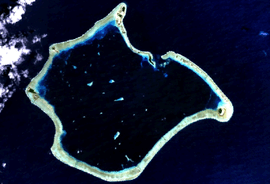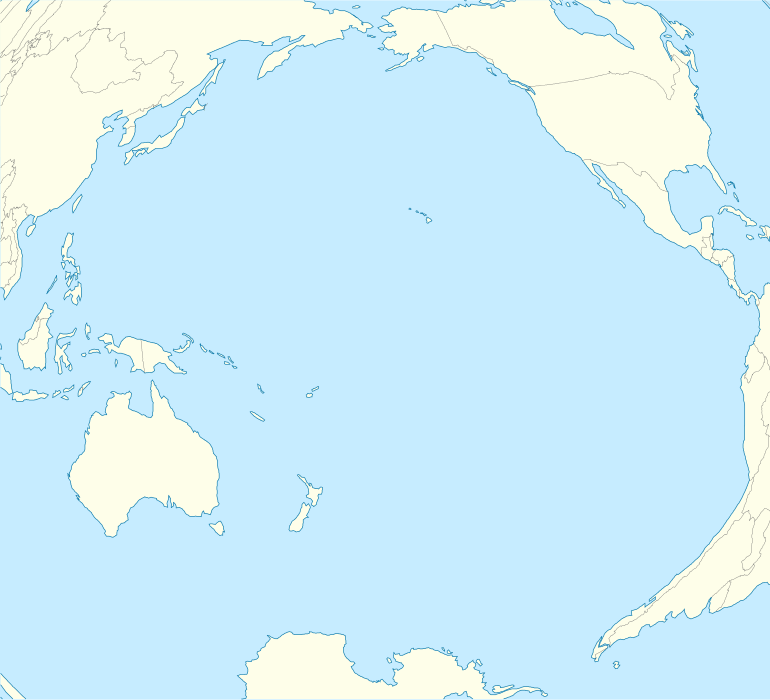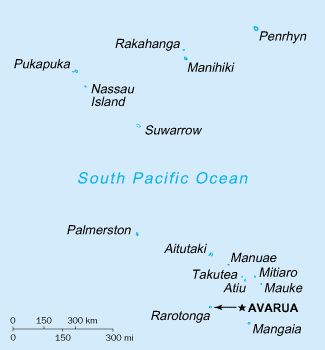Suwarrow
Suwarrow (also called Suvorov, Suvarou, or Suvarov) is an island in the northern group of the Cook Islands in the south Pacific Ocean. It is about 1,300 kilometres (810 mi) south of the equator and 930 kilometres (580 mi) north-northwest of the capital island of Rarotonga.
 Satellite image of Suwarrow. Anchorage Island is immediately west of the lagoon's entrance | |
| Geography | |
|---|---|
| Location | Central-Southern Pacific Ocean |
| Coordinates | |
| Archipelago | Cook Islands |
| Area | 9.8 km2 (3.8 sq mi) |
| Administration | |
| Demographics | |
| Population | 2 (seasonal) |
| Ethnic groups | Polynesian |


Geography

Suwarrow is a roughly quadrilateral-shaped coral atoll, 80 kilometres (50 mi) in circumference, with over 20 small islets (motu) surrounding a central lagoon 19 by 8 kilometres (11.8 by 5.0 mi). Cyclones have often created storm surges which sweep over the atoll since its small component of land is extremely low-lying.
Table of Islets
| Island | Area km2 | Population |
|---|---|---|
| Anchorage Island | 0.139 | 1 |
| East Island | 0.278 | 0 |
| Entrance Island | 0.014 | 0 |
| Manu Island | 0.121 | 0 |
| Motu tou Island | 0.31 | 0 |
| One Tree Island | 0.134 | 0 |
| Other (Brushwood Island, Whale Island, Gull Island) | 0.39 | 0 |
| Turtle Island | 0.214 | 0 |
| Suwarrow total | 1.6 | 1 |
History
Although Suwarrow was inhabited by Polynesians during prehistory[1] it was uninhabited when discovered by the Russian-American Company ship Suvorov, which reportedly followed clouds of birds to the atoll on September 17, 1814. (The ship was named after Russian general Alexander Suvorov, who appears as "Suwarrow" in Lord Byron's epic poem Don Juan and also in Alaric Alexander Watt's alliterative poem "The Siege of Belgrade".) It has been only intermittently inhabited since. The atoll's name has also been spelled variously as Souvorow, Souwaroff, and Souworoff. "Suwarrow" is the official spelling adopted by New Zealand.
In April 1890 Robert Louis Stevenson, his wife Fanny Vandegrift Stevenson, and her son Lloyd Osborne were passengers on the trading steamer Janet Nicoll, which called at Suwarrow during a trading cruise around the central Pacific.[2] The journal of Fanny Vandegrift Stevenson was published under the title The Cruise of the Janet Nichol.[3] Jack Buckland was also a passenger on Janet Nicoll; he later returned to Suwarrow to be the island trader.
In the mid-19th century (records dispute whether it was in 1848 or 1855), a ship from Tahiti was carrying out salvage work when a box containing NZ$15,000 worth of coins was dug up.[4] Some years later, New Zealander Henry Mair found pieces of eight in a turtle nest. Mair became involved in a dispute, the find was covered up, and it has never been rediscovered.[5]
In 1876 the atoll was leased to an Auckland firm who built a wharf, installed a light on a wooden pyramid, and commenced to gather mother of pearl. British sovereignty was proclaimed April 22, 1889. In 1903 the atoll was leased to Lever Brothers, "for the purpose of removing guano or other fertilising substances therefrom, and of planting the land with coconuts, and for collecting pearl-shells, and for other purposes of a like nature." They maintained about thirty persons on the island until a cyclone in 1914 so severely damaged operations that the island was abandoned.
During World War II, Robert Dean Frisbie and several coast watchers lived on the largest islet, Anchorage. Frisbie wrote about his experiences in The Island of Desire. In 1942, a cyclone washed away 16 of the 22 islets in the atoll. The coastwatchers left a hut with water tanks behind, and left wild pigs and chickens on the islet. Later, cats were allowed to run wild on Anchorage Island, to control Polynesian rats which were documented to occur there since the island was discovered by Europeans (Jones 2001) but conceivably were introduced by Polynesian seafarers a longer time ago.
New Zealander Tom Neale lived alone on Suwarrow for a total of 16 years in three periods between 1952 and 1977. He described his experience in the first two of those periods in An Island to Oneself (1966 ISBN 0-918024-76-5). In 1964, while Neale was in Rarotonga, June von Donop, a former accountant from Honolulu, Hawaii, lived alone in his house on Suwarrow for a week, while her crewmates on the schooner Europe stayed on board their vessel. Michael Swift lived alone on Suwarrow in 1965-66, but he was not familiar with survival techniques and had a hard time finding sufficient food.[6]
In 1978, the island was declared a National Park of the Cook Islands due to the plentiful marine and bird wild life it supports.[7] The island and surrounding water is Crown land. A proposal to establish an aquaculture operation to farm Tahitian pearls was successfully opposed by Cook Islands environmental NGO, the Taporoporo'anga Ipukarea Society.
In October 2011, Russian politician Anton Bakov claimed to have purchased the atoll and declared it the capital of a new Russian Empire.[8] The claim was denied by Prime Minister Henry Puna.[9]
Fauna and flora
At the end of the 20th century, 3% of all red-tailed tropicbirds in the world (some 400) bred there, as well as 9% of the global population of the lesser frigatebird (about 8500, though only a part of these seem to be present at any one time).(Jones 2001)
Most of the small islets have only herbs and shrubs, with Pemphis acidula and beach heliotrope (Tournefortia argentea) growing in abundance. The larger islands have a dense interior vegetation of Cordia subcordata (tou); indeed, the westernmost island, Motu Tou is named after this woodland.(Jones 2001)
Suwarrow has a rich marine biodiversity, which supports megafauna such as sea turtles, sharks, mantas,[10] and cetaceans including humpback,[11][12] sperm,[13] and false killer whales.[14][15]
Demographics
Every five years, the Cook Islands government advertises for the Suwarrow island nature reserve caretaker position. The position is staffed between April and October by two persons.[16] The caretakers act as customs officers for visiting yachets, as well as monitoring the atoll's birdlife.[17] Previous caretakers have brought their families with them, so the population was significantly higher, but that is not the case today. The barge that brings them also brings six months of supplies such as canned food, and several more rangers that clean the island on the first day and leave the caretakers behind.[18]
The only way to visit the island is with a private yacht or by chartered expedition from Rarotonga, and visitors require permits from the park authorities before being permitted to land.[19]
Notes
- Best, Elsdon (1923). "Intrepid Polynesian Voyagers". Polynesian Voyagers. The Maori as a Deep-sea Navigator, Explorer, and Colonizer. p. 9.
- Janet Nicoll is the correct spelling of the name of the trading steamer owned by Henderson and Macfarlane of Auckland, New Zealand, which operated between Sydney, Auckland, and the central Pacific. Fanny Vandegrift Stevenson misnames the ship Janet Nicol in her account of the 1890 voyage,The Cruise of the Janet Nichol.
- The Cruise of the Janet Nichol among the South Sea Islands A Diary by Mrs Robert Louis Stevenson (first published 1914), republished 2004, editor, Roslyn Jolly (U. of Washington Press/U. of New South Wales Press)
- Helm and Percival
- Cowan, James (1936). Suwarrow Gold and other stories of the Great South Sea.
- Helm and Percival, pp 63, 100, 105
- National Environment Service of Cook Islands Archived 2006-05-20 at the Wayback Machine
- "Russians claiming Suwarrow". Cook Islands News. 2011-10-01. Retrieved 2011-10-16.
- "Russian mission foiled by seasickness". Cook Islands News. 2011-10-05. Retrieved 2011-10-16.
- AN OCEAN OF SURPRISES - Suwarrow: A real treasure island. Retrieved on April 05, 2017
- Webb B.. 2014. Shipwrecked in shelter. Boating NZ. Stuff.co.nz. Retrieved on April 05, 2017
- Webb B.. Morgan D.. 2014. An Island almost to Oneself. Retrieved on April 05, 2017
- The Cook Islands Biodiversity& Natural Heritage. Physeter macrocephalus To‘ōra Sperm Whale. The Cook Islands Natural Heritage Trust
- Elaine and Bob. 2011. In Suwarrow. Retrieved on April 05, 2017
- Gleinig M.. Photos by Marcus Gleinig. The Panoramio. Retrieved on April 05, 2017
- "Suwarrow Atoll National Park". National Environmental Service. Retrieved 3 August 2020.
- "Suwarrow caretakers on their way north". Cook Islands News. 29 April 2015. Retrieved 3 August 2020.
- "Harry lives the Suwarrow life". Cook Islands News. 12 May 2018. Retrieved 3 August 2020.
- "Mariner information". Cook Islands Port Authority. Retrieved 3 August 2020.
To visit Suwarrow Atoll National Park, one should obtain permission from the resident Park Administrator(National Environment Services)
References
- Frisbie, Robert Dean (1944): The Island of Desire. (full text).
- Helm, A.H; Percival, W.H (1973): Sisters In The Sun: The Story of Suwarrow and Palmerston Atolls. ISBN 0-7091-3971-3.
- Jones, Rhys J. (2001): The status of seabird colonies on the Cook Islands atoll of Suwarrow. Bird Conservation International 11(4): 309–318. doi:10.1017/S0959270901000351 (HTML abstract)
- Neale, Tom (1966): An Island to Oneself. ISBN 0-918024-76-5.
- Waterworth. J. Y. (1954): Siege of Suwarrow. Walkabout March 1: 34-35.
External links
| Wikimedia Commons has media related to Suwarrow. |